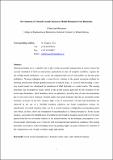| dc.contributor.author | Nash, Stephen | |
| dc.contributor.author | Hartnett, Michael | |
| dc.date.accessioned | 2014-01-13T16:35:45Z | |
| dc.date.available | 2014-01-13T16:35:45Z | |
| dc.date.issued | 2014-03 | |
| dc.identifier.citation | Nash S and Hartnett M (2014) 'Development of a nested coastal circulation model: boundary error reduction'. Environmental Modelling & Software, 53 :65-80. | en_US |
| dc.identifier.issn | 1364-8152 | |
| dc.identifier.uri | http://hdl.handle.net/10379/3967 | |
| dc.description | Journal article | en_US |
| dc.description.abstract | Numerical models have a valuable role to play in the sustainable management of coastal waters but accurate simulation of land/sea interactions, particularly in areas of complex coastlines, requires the use of high spatial resolutions. As a result, the computational cost of such models can become quite prohibitive. Nesting techniques offer a cost-effective solution to the spatial resolution problem by allowing specification of high spatial resolutions in limited areas, i.e. selective down-scaling. A one-way nested model was developed for simulation of tidal hydraulics in coastal waters. The nesting procedure was developed to reduce errors in the nested domain generated by the treatment of the nested open boundaries. Such 'boundary errors' are primarily caused by loss of mass and momentum due to non-conservative boundary schemes and/or inaccurate boundary data due to unsuitable nested boundary locations. In the first instance, high levels of conservation of mass and momentum are achieved by the use of a Dirichlet boundary condition and linear interpolation scheme for specification of nested boundary data, and by a nested boundary configuration incorporating ghost cells which, in effect, allows the formulation of open boundaries as 'internal boundaries'. In the second instance, a procedure for identification of suitable nested boundary locations ensures the level of error passed from the low resolution solution to the nested solution via the boundary prescription is low. Nested model functionality was verified for both experimental and natural test conditions. The nesting procedure was found to reduce boundary errors and produce highly accurate solutions for a fraction of the computational cost of high resolution single grid models. | en_US |
| dc.format | application/pdf | en_US |
| dc.language.iso | en | en_US |
| dc.publisher | Elsevier | en_US |
| dc.relation.ispartof | Environmental Modelling & Software | en |
| dc.rights | Attribution-NonCommercial-NoDerivs 3.0 Ireland | |
| dc.rights.uri | https://creativecommons.org/licenses/by-nc-nd/3.0/ie/ | |
| dc.subject | Nested model | en_US |
| dc.subject | Hydrodynamics | en_US |
| dc.subject | Boundary errors | en_US |
| dc.subject | Ghost cells | en_US |
| dc.subject | Internal boundary | en_US |
| dc.title | Development of a nested coastal circulation model: boundary error reduction | en_US |
| dc.type | Article | en_US |
| dc.date.updated | 2013-12-18T12:34:47Z | |
| dc.identifier.doi | 10.1016/j.envsoft.2013.11.007 | |
| dc.local.publishedsource | http://dx.doi.org/10.1016/j.envsoft.2013.11.007 | en_US |
| dc.description.peer-reviewed | peer-reviewed | |
| dc.contributor.funder | |~| | |
| dc.internal.rssid | 5195712 | |
| dc.local.contact | Stephen Nash, Dept. Of Civil Engineering, Room N103, Civil Engineering Building, Nui Galway. 3738 Email: stephen.nash@nuigalway.ie | |
| dc.local.copyrightchecked | Yes | |
| dc.local.version | ACCEPTED | |
| nui.item.downloads | 689 | |


